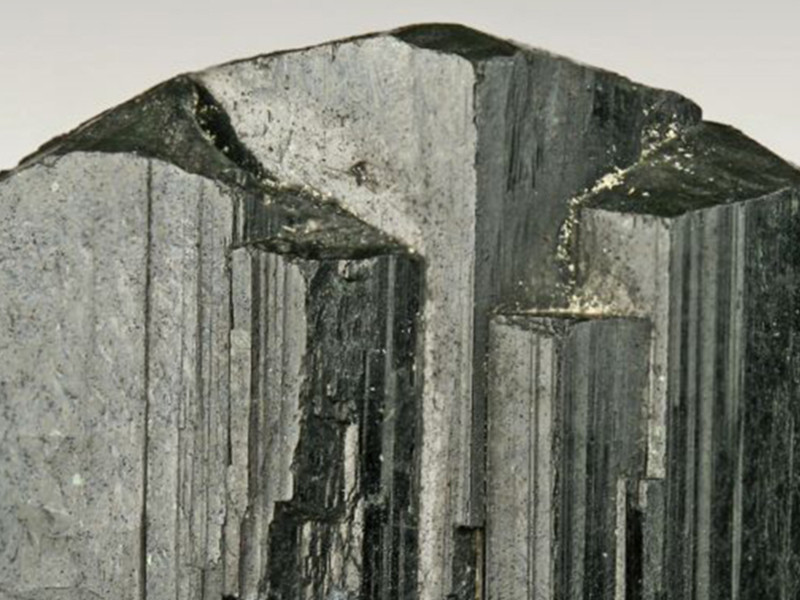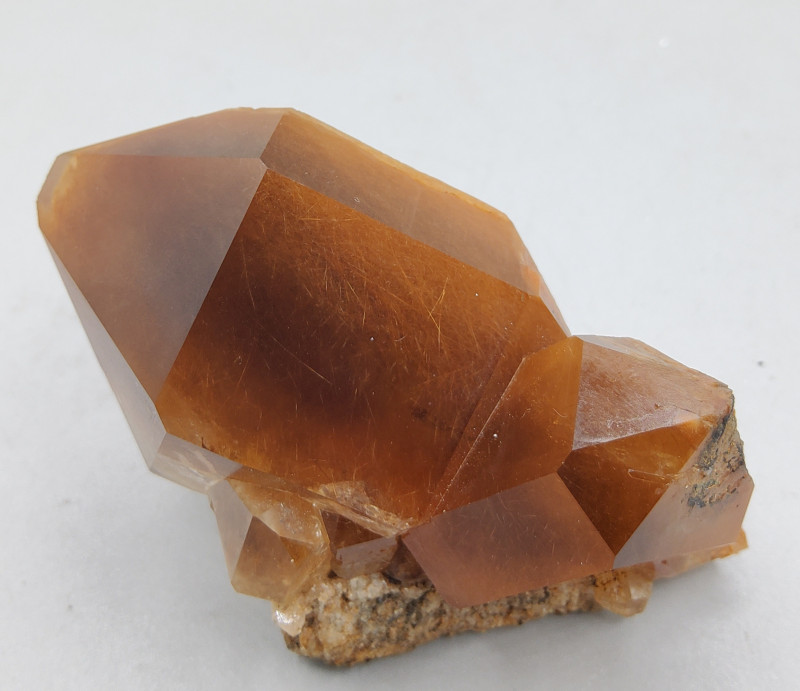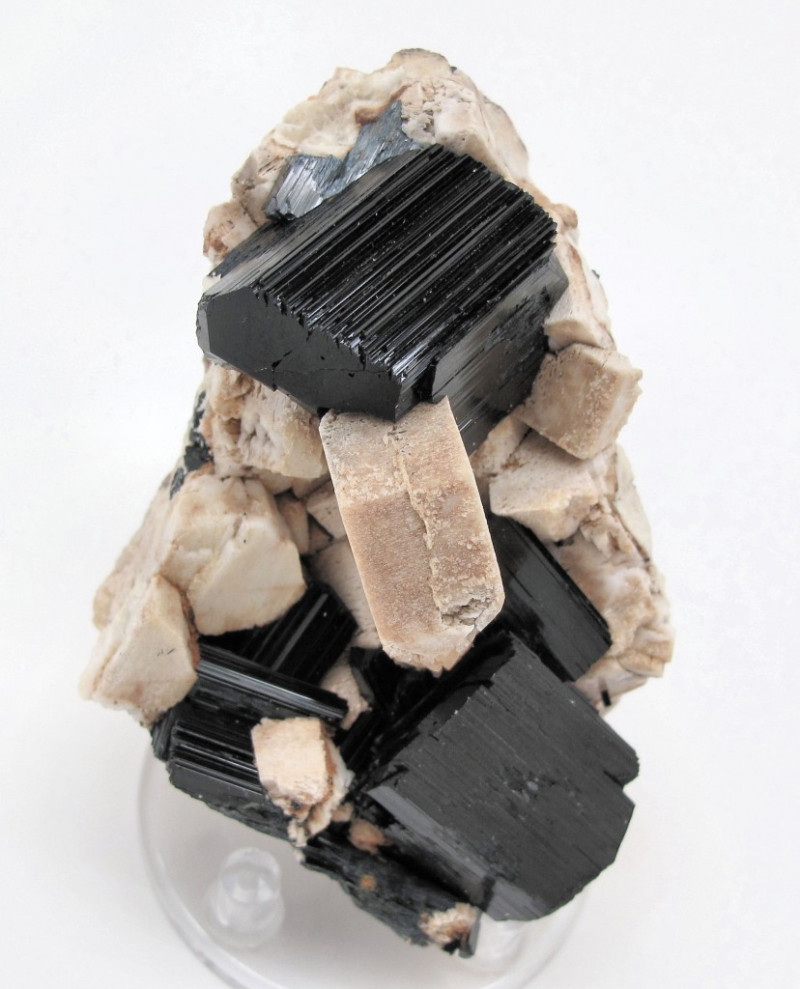
Arfvedsonite Gemstone: Properties, Meanings, Value & More
 Arfvedsonite (pronounced ar-VED-suhn-ait) is a rare, dark-colored gemstone popular among collectors and crystal healers. What color is arfvedsonite? The color ranges from dark blue or blue-green to bluish-black or fully black, often with iridescent-like flashes of blue streaking across the surface.
Arfvedsonite (pronounced ar-VED-suhn-ait) is a rare, dark-colored gemstone popular among collectors and crystal healers. What color is arfvedsonite? The color ranges from dark blue or blue-green to bluish-black or fully black, often with iridescent-like flashes of blue streaking across the surface.
In collector circles, arfvedsonite is a rare and lucky find with a deep color that adds mystery and depth to any collection. Among crystal healers, the stone is a powerful source of light and confidence, perfect for bringing out your best self.
Want to know more? Join us as we discuss all things arfvedsonite, from its mineral properties to its healing powers and more.

What Is Arfvedsonite Stone?
Arfvedsonite is a very rare semi-precious gemstone with flashes of blue on a dark base, similar to labradorite. Some of arfvedsonite’s other names include alkali amphibole and soda hornblende. Based on its flashes of color, some also call it “firework stone.”
Though not a birthstone, arfvedsonite with garnet is a common mixture, making it an interesting new twist on the traditional garnet January birthstone. Additionally, arfvedsonite is a zodiac stone for Gemini and a planetary star stone for Mercury.
The combination with garnet is seen in arfvedsonite with dark red garnet inclusions. These inclusions may sometimes be eudialyte, though, so be wary of sellers trying to upsell you.
Mineralogically, what are the properties of arfvedsonite?
Arfvedsonite Specifications & Characteristics
The mineral arfvedsonite is a sodium amphibole with the formula [Na][Na2][(Fe2+)4Fe3+][(OH)2|Si8O22]. All those symbols and numbers mean arfvedsonite is composed of sodium, iron, silica, and hydroxide.
Other amphibole minerals include tremolite, hornblende, actinolite, and riebeckite.
Usually, arfvedsonite occurs as fibrous crystals with a dark sheen, though its silvery blue coloring comes out once it’s polished. The stone may also occur as prismatic shards, often radiating stellates (resembling a star).
The dispersion (or fire) of arfvedsonite is incredibly high, meaning it displays strong colorful sparkles.
The blue flashes on arfvedsonite may appear similar to play-of-color seen in precious opal, for instance, but they’re actually a result of the stone’s pleochroism. You’ll only see the effect when the stone is polished.
Speaking of, here are the rest of arfvedsonite’s mineral properties:
Mohs hardness: 5-6
Color: Dark blue to black with blue color flashes
Crystal structure: Monoclinic
Luster: Vitreous (glassy)
Transparency: Translucent to opaque
Refractive index: 1.65-1.70
Density: 3.3-3.5
Cleavage: Perfect 1-direction on [110]
Fracture: Uneven
Streak: Deep bluish-gray
Luminescence: None
Pleochroism: Present in gray-violet, yellowish-brown, and blue-green shades
Before we get into the mystical side of arfvedsonite, let’s make sure you know how to identify it when coming across similar-looking stones — particularly astrophyllite.
 Pictured above: Astrophyllite
Pictured above: Astrophyllite
Arfvedsonite vs. Astrophyllite
There are a few stones that arfvedsonite may be confused with, such as hornblende and nuummite. However, the most common mix-up is between arfvedsonite and astrophyllite.
Astrophyllite is a similarly rare gemstone with a brown to brassy or golden-yellow hue. It’s commonly found in a cream, gray, or off-white matrix (composed of nepheline syenite) where the astrophyllite appears as radiating star-like shapes.
Similar to arfvedsonite, astrophyllite has a shimmery surface. Both stones can also grow with eudialyte, seen as pinkish-red portions.
What is the difference between astrophyllite and arfvedsonite?
The first visual distinguishing feature is the color of each stone’s shimmer. Astrophyllite always has a copper, reddish-brown, or bronze shimmer, while arfvedsonite has a blue shimmer.
At a chemical level, astrophyllite is a hydrous potassium iron titanium silicate, while arfvedsonite is a sodium amphibole. Lastly, astrophyllite only ranks at 3 on the Mohs mineral hardness scale, making it softer than arfvedsonite.
With the mineral side done, let’s get into arfvedsonite’s symbolism and history!
Arfvedsonite Meaning & Discovery
Many spiritual practitioners call arfvedsonite the “Stone of Truth.” The crystal symbolizes self-awareness, purpose, and manifestation. It’s often described as being a “light at the end of the tunnel” of sorts — a companion for anyone feeling lost in life.
The name “arfvedsonite” honors Swedish chemist Johan August Arfvedson (or Arfwedson) who discovered the stone during 1823 in Greenland. Arfvedson is perhaps more well-known for discovering lithium in 1817 when he was analyzing petalite.
Honing in on the spiritual side again, what is arfvedsonite crystal good for healing?
 Image credit: Carles Millan | Creative Commons Attribution 3.0 Unported license
Image credit: Carles Millan | Creative Commons Attribution 3.0 Unported license
Arfvedsonite Healing Properties
All gemstones can function as healing stones, and their abilities can be partly dictated by their coloring. In arfvedsonite’s case, this stone joins other black gems in offering protection, grounding, and positive energies.
That said, the blue flashes in arfvedsonite also evoke the benefits of blue gemstones, such as enhancing concentration and inner peace.
What is arfvedsonite used for in physical and emotional healing?
Physical Healing
Unlike other crystals, arfvedsonite isn’t commonly used to treat specific physical ailments. Rather, its purported emotional benefits help bring an overall feeling of wellness and healing that harmonizes the physical, emotional, and spiritual body.
However, arfvedsonite throat chakra stones may be helpful in resolving physical symptoms of a blockage such as sore throats, neck pain, and thyroid issues.
Emotional Healing
Crystal healers most often recommend arfvedsonite for relieving anxiety, tension, and melancholy. The stone is said to help you identify what drives you, discover your purpose, and pursue your goal with passion.
Arfvedsonite is also believed to help you stay calm and collected during difficult circumstances, especially when handling everyday tasks makes you want to scream or just feels impossible. The crystal reminds you what you’re working toward and helps you get there with a positive attitude.
Chakra Healing
Chakra healing is the ancient practice of balancing energy centers (chakras) along the body to resolve blockages. These blockages result in negative symptoms, so opening or balancing the chakra brings the system back into balance so energy can flow.
One method for balancing chakras is by using chakra stones specifically associated with the chakra you’re targeting.
Arfvedsonite crystals are chakra stones for the throat chakra, located at… you guessed it, the throat! It governs how well we know ourselves and how we communicate our truth.
When this chakra is blocked, you may feel stifled creatively or unable to express what you’re feeling. Opening the throat chakra with arfvedsonite allows you to understand and speak your truth without hesitation or fear.
 Image credit: Carles Millan | Creative Commons Attribution 3.0 Unported license
Image credit: Carles Millan | Creative Commons Attribution 3.0 Unported license
Arfvedsonite Gemstone Properties
The objective value of arfvedsonite as a gemstone is determined by its quality in the categories of color, cut, clarity, and carat weight.
Color
Arfvedsonite is always dark, but the extent of streaks showing blue flashes varies from stone to stone. Stones that show more flashes are typically more valuable.
You may also see flashes of reddish hues; these are caused by ionization. In contrast, portions of reddish to pink hues may be caused by inclusions of garnet or eudialyte.
Cut
Arfvedsonite is rarely ever faceted, but it can be cut in various interesting shapes. Though cabochons and tumbled stones are the standard, you’ll often see stars, beads, spheres, and even an arfvedsonite tower or skull.
Clarity
Clarity represents how many visible inclusions are present in a stone. In arfvedsonite’s case, inclusions may offer additional value, such as garnet inclusions.
However, colored inclusions may also deter buyers who want a more consistent coloring, so they don’t always have the same influence on value.
Interestingly, gemologists recently discovered that the dotted inclusions in dalmation jasper (or dalmation stone) are actually arfvedsonite, not black tourmaline as was long thought.
Carat Weight
As with most gems, rare ones in particular, arfvedsonite’s size will significantly influence its price. Larger carvings with more intricate designs are especially more valuable.
Moving on, how does arfvedsonite form?
 Image credit: Rob Lavinsky, iRocks.com – CC-BY-SA-3.0
Image credit: Rob Lavinsky, iRocks.com – CC-BY-SA-3.0
Arfvedsonite Origin & Sources
Arfvedsonite forms over a very long period of time — we’re talking millions of years — inside plutonic rocks. “Plutonic” refers to igneous rocks that form through magma very gradually cooling and solidifying below ground. These igneous rocks are also called “intrusive” types.
Which plutonic rocks does arfvedsonite form inside of? Usually, you’ll find the mineral inside nepheline syenites, granites, or peralkaline pegmatites.
Where does this formation process take place? Only a few select locales!
Mining Locations
Part of arfvedsonite’s rarity comes from its limited sources, most of which have ceased production.
The arfvedsonite sources are:
Australia
Canada
DR of Congo
Denmark
Germany
Greenland
Norway
Macedonia
Malawi
New Zealand
Russia
South Africa
USA (Arkansas, Colorado,
Zambia
Of course, we have to talk about cost. What should you expect in terms of price when shopping for arfvedsonite?
Arfvedsonite Price & Value
Despite its rarity, arfvedsonite stones are more affordable than you’d think! Starting with specimens of raw arfvedsonite, these run from $25 to $50 typically.
Tumbled stones and palm stones range from $7 to $20, mostly depending on size and amount of blue flashes on the surface. Spheres fetch between $25 to $50, based on similar factors.
Arfvedsonite towers (also called crystal points) usually cost between $15 to $30, though especially large ones can be $40 to $80 each. Strands of arfvedsonite beads range from around $10 to $20.
Before we wrap up, you’ll want to know how to care for your gemstone!
Arfvedsonite Care and Maintenance
Arfvedsonite has relatively good hardness, so it won’t scratch too easily. Still, you may want to get jewelry with protective settings for extra safety.
If you have a rough arfvedsonite, caring for the stone takes extra precaution. Since it’s an amphibole (a.k.a. asbestos) mineral, breathing in fibers of arfvedsonite is highly dangerous. It’s best to wear gloves and a face mask when caring for raw specimens.
Polished arfvedsonite, on the other hand, is completely safe because the fibers won’t flake off. You can clean these stones by wiping them down with a soft, microfiber cloth.
Find Your Light with Arfvedsonite!
These days, it can be hard to find the light at the end of the tunnel among the onslaught of stressful news, but arfvedsonite is here to help. The crystal may have a dark interior, but its soothing blue color flashes remind us to seek out the light in ourselves and allow that spark to keep us going!
Search the Gemstone Encyclopedia
Related Auctions
Related Articles
Originally the Birthstones or gemstones were associated with a zodiac sign or the month of a individuals birth. Find out what your stone is and view the stones we have for sale
8th Feb 2021
There are dozens of quartz and chalcedony gems with various colors and patterns. Learn all about quartz properties and every type of quartz, from amethyst and agate to plasma and phantom quartz!
15th Oct 2020
Hackmanite is a pink to violet sodalite gem known for its unique color-change and luminescence. Learn why hackmanite is special, from its rare qualities to the types of hackmanite jewelry available.
28th Mar 2018
Latest Articles
Shortite is a rare mineral and rarer gemstone, usually found as colorless or yellow wedge-shaped crystals. Learn the value, history, and properties of shortite in this guide!
9th Dec 2024
Senarmontite is an uncommon antimony mineral mostly used industrially but occasionally collected as rare gems or pearly crystals. Find out all of the traits, uses, prices, and history of senarmontite.
27th Nov 2024
Tantalite is a group of red, brown, or black minerals containing the rare and valuable element tantalum. Discover the uses, history, prices, and properties of tantalite gemstones in this guide!
11th Nov 2024
Article Categories
How To's is where you will find helpful articles from gem Rock Auctions on how to cut gemstones, select gemstones and buy gemstones.
9 Articles




